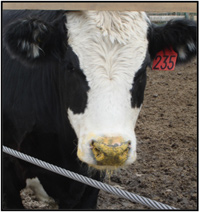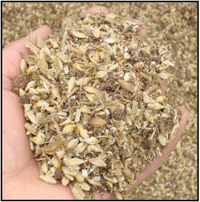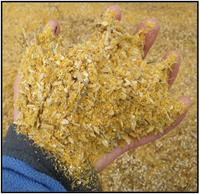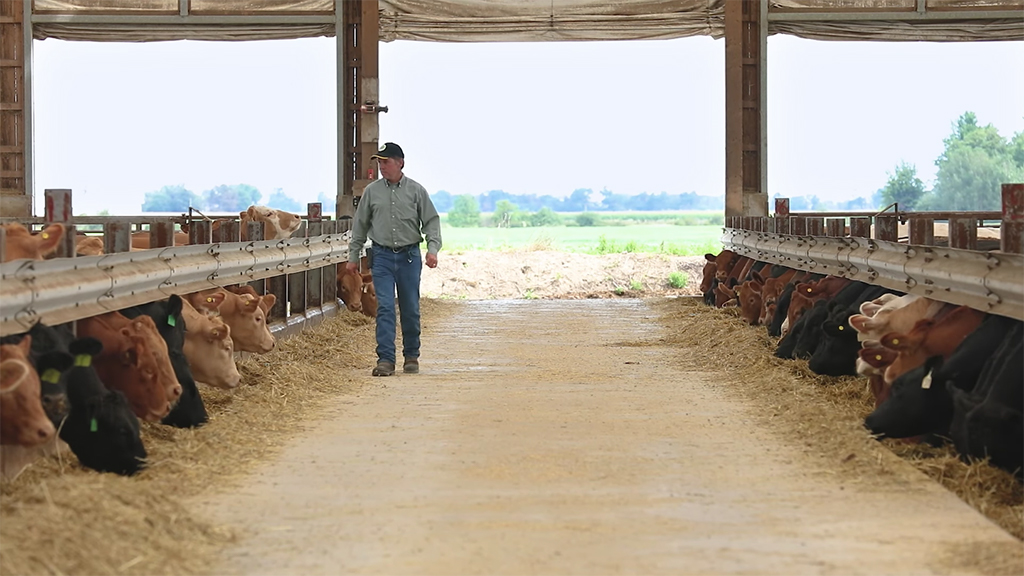Distillers’ Grains for Beef Cattle
Distillers’ grains are a by-product of grain-based ethanol production and can be a cost-effective source of energy and protein for beef cattle. Most distillers’ grains in North America come from corn with some from sorghum and wheat. According to Renewable Industries Canada1, as of 2020 the majority of Canadian bioethanol production occurs in Eastern Canada where almost 1.3 billion litres/year is produced as compared to Western Canada’s 810 million litres/year. Corn distillers’ grains are sold and produced primarily in Eastern Canada. Wheat distillers’ grains, or a mixture of wheat and corn, are produced in Western Canada.
| Key Points |
|---|
| Distillers’ grains are available in many different forms, including thin stillage, wet distillers’ grains (WDG), dried distillers’ grains (DDG), and wet or dried distillers’ grains with solubles (WDGS or DDGS). |
| Protein, fibre, phosphorus and sulfur are roughly three times as concentrated in DDGS than in the original grain. The same will apply to fat, provided the fat hasn’t been removed from the DDGS. |
| DDGS and WDGS are both very palatable when mixed into a complete feed or fed as a supplement that is top-dressed onto the base diet. |
| Distillers’ grains with solubes can be an excellent source of protein and energy for all classes of beef cattle. |
| Corn DDGS enhances feed efficiency up to 5%, with the maximum response from between 10 and 20% inclusion in the diet. |
| Phosphorus (P) levels are typically high in DGS. Diets containing DGS must be fortified with additional limestone. |
| Sulfur (S) levels are high in DGS and quite variable (0.35 to 1.4%). Levels of S in the diet above 0.4% can be toxic to feedlot cattle. |
Production and Types
DDGS = Dried distillers’ grains with solubles
WDGS = Wet distillers’ grains with solubles
Distillers’ grains are the major by-product of ethanol production. To produce biofuels, cereal grains are heated and fermented. The starch is converted into ethanol and removed. The mixture of concentrated protein, fibre, oil and minerals, which remains is called stillage.
Stillage is sold either wet (20 to 30% dry matter) or dry (90% dry matter). Stillage remaining after the fermentation and distillation process is low in solids and is sometimes fed directly to livestock through the watering system (thin stillage).
Typically, stillage is further separated into distillers’ grains and solubles. Solubles are recovered and incorporated into the distillers’ grains, called distillers’ grains with solubles (DGS). DGS can be used wet (WDGS) but is most often dried (DDGS) to reduce shipping costs. Dried distillers’ grains with solubles are the most common form of DGS available for use in beef cattle diets.
Composition of Distillers’ Grains

Photo credit: Lee-Anne Walter
There is considerable variation in the composition of distillers’ grains. Composition may be partially reflected by whether grain is processed by dry or wet milling before it is fermented.
Due to the majority of the starch in the grain being removed during the distillation process, concentration of other components, except calcium, is enhanced significantly. For example, fat, protein, fibre, phosphorus and sulfur are roughly three times as concentrated in DDGS than in the original grain.
Composition of Distillers’ grains and parent grains, % dry basis
| Corn distillers’ grain* | Corn grain** | Wheat distillers’ grain* | Wheat grain** | |
|---|---|---|---|---|
| Protein | 32.4 to 34.5 | 9.0 | 30.6 to 44.7 | 14.0 |
| Crude fat (oil) | 5.6 to 8.3 | 4.0 | 3.7 to 4.4 | 2.0 |
| Fibre (NDF) | 34.1 to 48.1 | 10.8 | 22.7 to 36.5 | 12.0 |
| Calcium | 0.02 to 0.03 | 0.03 | 0.02 to 0.03 | .08 |
| Phosphorus | 0.75 to 1.21 | 0.30 | 0.83 to 0.95 | 0.36 |
*Encompasses both wet and dry distillers’ grains. Corn and wheat distillers’ values from Lethbridge Research Station, University of Saskatchewan and Spiehs et al., Journal of Animal Science (2002) vol. 80, p. 2639.
**Grain values from Nutrient Requirements of Beef Cattle, 8th revised edition (2016).

Photo credit: Lee-Anne Walter
Dietary starch, fibre and protein levels can affect the pH of a ruminant’s digestive tract, which may in turn affect how well various microbes survive and compete in the animal’s rumen, intestine and manure. This can affect animal health and welfare, food safety and feed efficacy.
The method used to dry DDGS can also affect the nutritional value. Due to the various factors (grain type, moisture, solubles, milling and drying) that can influence composition, a feed test is recommended before using these by-products to feed beef cattle to determine the nutritional value of the DDGS (protein, fat, and energy content, etc). Producers may need to feed additional supplements or remove them from the feed plan entirely if certain nutrient levels aren’t met. Producers can use ration balancing software, such as CowBytes, to safely balance rations using alternative feeds.
Receiving and Handling

Photo credit: Lee-Anne Walter
Distillers’ grains with solubles can be transported and handled similar to other grain commodities. No special storage and handling facilities or equipment are required.
It is typically uneconomical to transport WDGS over great distances due to its high-water content and short shelf life. This leads to more weight per load which then increases the cost of shipping. The brief shelf life also contributes significantly to the uneconomical nature of WDGS as producers have often observed spoilage during longer shipments, as well as during prolonged storage.
Wet distillers’ grains with solubles will deteriorate quickly in the open. However, they may be stored for many months with under 10% loss of nutrients if:
- in a bunker silo (either alone or in combination with wet processed grain or forage), and
- it has been stored correctly with effective ensiling practices.
Feeding Distillers’ Grains to Beef Cattle
Dried distillers’ grains with solubles and WDGS are both very palatable when mixed into a complete feed, or fed as a supplement that is top-dressed onto the base diet.
Feedlot operators throughout North America routinely use DDGS in feedlot rations as a means of reducing feed costs while meeting animal nutritional requirements. The expansion of North America’s ethanol industry has increased feed grain costs and subsequently increased the use of distillers’ grains as livestock feed.
This by-product can be a valuable source of dietary protein or energy for cattle, depending how they are fed.
At levels below 15% of the diet, on a dry matter basis, DGS are an excellent alternative to soybean or canola meal as a protein supplement. DGS is relatively high in rumen bypass protein with DDGS having slightly more than WDGS. This can mean that when there is a protein deficit from the basal diet, corn and wheat DGS can be more effective than soybean or canola meal in meeting the protein requirement of calves with a high protein demand, e.g. light weight and rapidly growing.
Dried distillers’ grains with solubles are an excellent source of energy at levels up to 45% of the diet (dry matter basis). Once the animal’s protein requirements have been met, excess dietary protein is used for energy instead.
Due to the high levels of fibre in DGS, there has been interest in using DGS in place of dietary roughage. However, the DG fibre particles are too small to effectively maintain proper rumen function and health and have been associated with increased incidence of rumen acidosis and liver abscesses. It should be noted that DGS are not meant to be used as a roughage source, but rather a source for energy and protein.
A Canadian study by Yang et al. (2011)2 found that a minimum of 10% barley silage was needed in a diet containing wheat DGS to prevent a rumen pH drop (increased acidity) in calves fed barley grain-based finishing diets.
Benefits of Feeding Distillers’ Grains to Feedlot Cattle
Corn WDGS enhances feed efficiency of corn-based diets by up to 13% with response proportional to the level in the diet up to 50% (dry basis). Corn DDGS enhances feed efficiency up to 5%, with the maximum response from between 10 and 20% inclusion in the diet. Overall, this increase in feed efficiency can lead to reduced costs if the DDGS are cheap enough. This is done mostly by reducing the amount fed, which either contributes to a larger profit margin or reduces losses for the producer. Other portions of the diet may need to be adjusted, based on a feed analysis of the distillers’ grain, to meet the cattle’s nutritional requirements.
At dietary inclusion rates up to 20% (20% of the animals’ entire diet is DDGS), wheat DDGS provide similar feed efficiency to a barley-based control diet. Above 20% inclusion, wheat DDGS have had no effect or caused a slight decline in feed efficiency, by up to 9%. However, according to a study funded by BCRC, adding various feed enzymes to rations containing wheat DDGS was found to improve an animal’s digestion of dry matter, fibre and protein. The best results occurred with the addition of the enzyme called xylanase. Wheat DDGS could replace 30% of barley in a ration. Provided enzymes are added to the ration – 2 mL/kg of dry matter was the proportion used in the study – the results are significant. This ration improved feed efficiency (defined as daily gain per kg of feed intake) by up to 5%. This could reduce costs if the distillers’ grain is cheap enough. However, if it is cost prohibitive, DDGS dietary inclusion rates will need to be reduced.
DDGS can be composed of varying amounts of oil content that remains. This amount can either be found on the label or determined by a feed test. A recent study by Ribeiro et al. (2016)3 has shown that feed efficiency and average daily gain (ADG) can also be influenced by the residual oil content of the DDGS and when low oil content DDGS (oil content of 5.6%), versus medium oil content DDGS (oil content of 8.3%) is fed.
The study showed that low oil DDGS fed in growing diets increased ADG by 7% compared to higher oil content distillers’ grains. Meanwhile, DDGS with higher residual oil content increased ADG by 2% compared to the low oil DDGS when fed in beef finishing diets. This shows that producers can maximize feed efficiency by using feed testing and the advice of a nutritionist to determine the DDGS oil content, and other nutritional values, so different distillers’ grains can be incorporated at different times of the animal’s growth cycle.
If a producer is formulating a ration for younger animals that are still growing, such as newly weaned calves, a low oil DDGS to maximize their ADG should be considered. Meanwhile older animals, such as yearlings or developed cows, who have finished growing benefit more from a medium oil content distillers’ grain. This, however, may be uneconomical for the producer if alternative feeds that provide a similar nutritional value are available at a lower cost.
Concerns with Feeding Distillers’ Grains to Feedlot Cattle
Diets containing DGS must be fortified with additional limestone over the amount used in grain diets to provide a calcium (Ca) to P ratio of at least 1.1 to 1, and preferably 1.5 to 1.
Calcium and Phosphorus Balance: Phosphorus (P) levels are typically high in DGS. Diets containing DGS must be fortified with additional limestone over the amount used in grain diets to provide a calcium (Ca) to P ratio of at least 1.1 to 1, and preferably 1.5 to 1.
The Ca:P ratio is important as calcium and phosphorus both play important roles in the bodily functions of cattle. A decrease in either or both can cause a decrease in weight gain and/or a decrease in efficiency of gain. During lactation, low amounts of either will reduce milk production. A superior milking cow requires three times more calcium than a non-lactating cow. A phosphorus deficiency can delay puberty in heifers and can delay mature beef cows from returning to estrus following parturition. Cattle also need correct amounts of calcium for the nervous and muscular systems to function properly.
Urinary calculi (kidney stones) are a symptom in male cattle of failing to balance the Ca:P ratio correctly, resulting in too much phosphorus in the diet. In some cases, this imbalance can lead to the development of ‘waterbelly ’ in cattle, a condition that may also be seen with other feeds, not just DDGS. Symptoms of waterbelly include frequent straining to urinate, prancing and/or kicking at the belly, and teeth grinding.
Sulfur (S) levels are high in DGS and quite variable (0.35 to 1.4%). Levels of sulfur in the total diet (including water) above 0.4%, on a dry matter basis, can be toxic to feedlot cattle.
Sulfur Toxicity: One of the symptoms of sulfur (S) toxicity in feedlot cattle, especially those fed barley-based diets, is polioencephalomalacia, a neurological disease. Clinical signs depend on the area of the cerebral cortex affected and may include head pressing, blindness, anorexia, muscle tremors, teeth grinding, convulsions, and more.
Sulfur levels are high in DGS and quite variable (0.35 to 1.4%). Levels of sulfur in the total diet (including water) above 0.4%, on a dry matter basis, can be toxic to feedlot cattle. Sulfur toxicity has been the subject of a several research projects funded by the BCRC. The first study concluded that that up to 50% corn-based distillers’ grains plus solubles can be fed in a 90% concentrate finishing diet without adversely affecting animal performance, carcass weight, quality or yield grade. However, the effects on animal health were unclear. Because of this lack of clarity, BCRC funded a later study into the impacts DDGS has on animal health. That study found that sulfur toxicity can be easily avoided by testing feed to know its mineral levels and maintaining the DDGS at levels no higher than 40% of the diet. It is also recommended to routinely evaluate water sources for mineral levels.
Land required for the application of feedlot manure is increased when DGS is fed.
Manure Application: Due to mineral levels in diets containing DG often exceeding beef cattle requirements, the manure from cattle fed DGS are particularly high in nitrogen (N) and P. In the application of cattle manure from DGS fed cattle to agricultural land, nutrient management programs can be used to take soil and crop requirements into account in good management of manure from feedlot cattle. Cattle manure can be a valuable resource in agriculture when utilized properly. This is easily done thanks to commercial agricultural testing labs located throughout Canada that can test nutrient levels in soil and manure and provide application rate recommendations based on these results.
To learn more about the potential benefits and drawbacks of feeding distillers’ grains and other feed options to consider, visit our Alternative Feeds page or read this article.
Feeding DGS to feedlot cattle does not consistently affect carcass grade and meat quality. However, there are two points worth noting:
- Some studies have shown that DGS inclusion decreases marbling of meat, but this is not a consistent finding and it cannot be easily explained.
- According to a BCRC study, feeding DGS negatively affects meat colour and colour stability of beef in the retail case when aged slightly before display. The significance of this in affecting consumer satisfaction is less clear. This effect of feeding DGS in feedlot diets can be counteracted by providing additional vitamin E.
Feeding Distillers’ Grains to Backgrounding Cattle
Distillers’ grains with solubles are an excellent energy and protein feed to use in total mixed rations (TMR) for backgrounding cattle. Calves fed forage and barley grain based diets in western Canada where wheat DDGS has replaced most of the barley grain have performed equally to calves on the forage and barley control diet.
DGS can be an ideal supplement for calves grazing summer pasture, stockpiled wheat, or other forage in the late fall and early winter before being shipped to the feedlot.
Feeding Distillers’ Grains to Cow-Calf
Distillers’ grains with solubles can be used as an energy source for supplementing forage based diets fed to beef cows and calves. Cows in mid-lactation have been fed as much as 15 kg (33 lbs) of WDGS daily. The precautions noted above for feedlot cattle regarding phosphorus and sulfur must be taken into consideration when using DGS for cow-calf rations.
In winter feeding systems, DDGS can be used as a protein supplement alongside low-quality forages to meet cow energy and protein requirements. In these feeding scenarios, the use of byproducts such as DDGS, canola meal or soybean meal, have been show to improve forage digestion as discussed in this past BCRC webinar.
- References
-
- Renewable Industries Canada (2020). Canadian Renewable Biofuel Producers, Blenders, and Distributors (interactive map). Retrieved from https://ricanada.org/industry-map/
- Yang, W., McAllister, T., Beauchemin, K., He, M.L., McKinnon, J. (2011). Effects of feeding ethanol by-products on rumen health. Beef Cattle Research Council: Evaluation of Distillers’ Grains from Ethanol Plants for Feedlot Cattle.
- Ribeiro, G.O., Hünerberg, M., Gibb D.J., McAllister, T.A. (2016). Effect of corn dried distiller’s grains plus solubles (DDGS) with medium and low residual oil content on growth performance of growing and finishing steers fed diets containing corn silage. Canadian Journal of Animal Science, 97(3):530-535.
Feedback
Feedback and questions on the content of this page are welcome. Please e-mail us at [email protected].
Acknowledgments
Thanks to Dr. Jock Buchanan-Smith, retired University of Guelph professor and researcher of beef cattle nutrition and management for contributing his time and expertise in writing this page.
Ce contenu a été révisé pour la dernière fois en Mars 2024.
